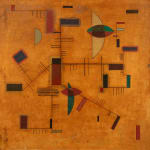




Wassily Kandinsky
Dichtes Braun (Condensed Brown), 1930
Signed with the artist's monogram 'K' and dated '30' (lower left); signed with the artist's monogram 'K,' titled "Dichtes Braun," dated '1930' and inscribed 'no. 502' (on the reverse)
Oil on panel
49 by 49 cm (19¼ by 19¼ in.)
68723
© 2023 Artists Rights Society (ARS), New York / ADAGP, Paris
Further images
Painted in February 1930. A pioneer of abstraction in Western art, Kandinsky firmly believed in a non-objective art form that transcended the traditional meaning of art. His experimentations with formal...
Painted in February 1930. A pioneer of abstraction in Western art, Kandinsky firmly believed in a non-objective art form that transcended the traditional meaning of art. His experimentations with formal autonomy and color theory are made visible in his vibrant and geometric compositions that favor the symbolic and rely on intuition to communicate meaning. Characteristic of the Bauhaus school of art which he taught at from 1922 to 1933, Kandinsky's use of geometric shapes, various lines, and intersecting angles exposes the underlying structures and essential elements of architecture and technological design. These elements are repeated and emphasized to establish rhythm and harmony and to express meaning through pictorial relationships and symbiotic connections.
Dichtes Braun (Condensed Brown) visualizes Kandinsky’s color theory and his intent to paint the meaning and feeling behind a work of art as opposed to literal representation. Focusing on the elements of form and color and the encounters between them, he rediscovers the laws of nature and reveals the inner energies of living organisms through a rigorous creative process. In the late 1920s, while teaching at the Bauhaus, Kandinsky was experimenting extensively with the color brown. In the present work, a series of intersecting lines, each with individual characteristic and tonalities, responds to the organic and biomorphic shapes that surround them.
Dichtes Braun (Condensed Brown) visualizes Kandinsky’s color theory and his intent to paint the meaning and feeling behind a work of art as opposed to literal representation. Focusing on the elements of form and color and the encounters between them, he rediscovers the laws of nature and reveals the inner energies of living organisms through a rigorous creative process. In the late 1920s, while teaching at the Bauhaus, Kandinsky was experimenting extensively with the color brown. In the present work, a series of intersecting lines, each with individual characteristic and tonalities, responds to the organic and biomorphic shapes that surround them.




